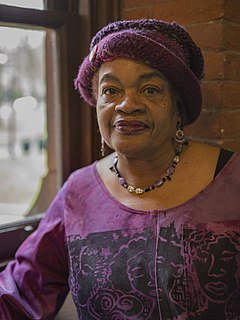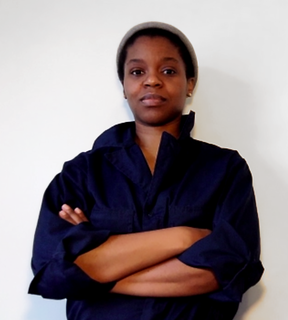Related Research Articles

Hannah Wilke was an American painter, sculptor, photographer, video artist and performance artist. Wilke's work is known for exploring issues of feminism, sexuality and femininity.

Chitra Ganesh is a visual artist based in Brooklyn, New York. Ganesh's work across media includes: charcoal drawings, digital collages, films, web projects, photographs, and wall murals. Ganesh draws from mythology, literature, and popular culture to reveal feminist and queer narratives from the past and to imagine new visions of the future.
Isca Greenfield-Sanders is an American landscape painter based in New York City.
Jean Shin is an American artist living in Brooklyn, NY. She is known for creating elaborate sculptures and site-specific installations using accumulated cast-off materials.

Aminah Brenda Lynn Robinson was an American artist who represented Black history through art.
Harmony Hammond is an American artist, activist, curator, and writer. She was a prominent figure in the founding of the feminist art movement in 1970's New York.
Sheila Pepe is an artist and educator living and working in Brooklyn, New York. She is a prominent figure as a lesbian cross-disciplinary artist, whose work employs conceptualism, surrealism, and craft to address feminist and class issues. Her most notable work is characterized as site-specific installations of web-like structure crocheted from domestic and industrial material, although she works with sculpture and drawing as well. She has shown in museums and art galleries throughout the United States.

Nina Kuo is a Chinese American painter, photographer, sculptor, author, video artist and activist who lives and works in New York City. Her work examines the role of women, feminism and identity in Asian-American art. Kuo has worked in partnership with the artist Lorin Roser.

Dindga McCannon, born July 31, 1947, is an African-American artist, fiber artist, muralist, teacher author and illustrator.
Ginger Brooks Takahashi is an American artist based in Brooklyn, New York, and North Braddock, Pennsylvania. A self-identified “punk,” Takahashi grew up in Oregon. She co-founded the feminist genderqueer collective and journal LTTR and the Mobilivre project, a touring exhibition and library. She was also a member of MEN (band). Her work consists of a collaborative project-based practice. Takahashi is currently an adjunct professor of Art at Carnegie Mellon University.
Elaine Reichek is a New York-based visual artist. Much of her work concerns the history of the embroidered sampler. Through her pieces of hand and machine embroidery and digital sewing machine, she addresses issues such as the craft/art and the old/new divide, the nature of women's work, and the interplay of text and image. The connection between the pixel and the stitch, as differently gendered types of mark-making, is a continuing theme in her work.

Arlene Shechet is an American artist. She lives and works in New York City, Woodstock, and Kingston, New York.
Kellie Jones is an American art historian and curator. She is a Professor in Art History and Archaeology in African American Studies at Columbia University. She won a MacArthur Fellowship in 2016.

Aisha Cousins is New York-based artist. Cousins writes performance art scores that encourage black audiences to explore their parallel histories and diverse aesthetics. Her work has been widely performed at art institutions such as Weeksville Heritage Center, BRIC, Project Row Houses, the Kitchen, the Brooklyn Museum of Art, MoCADA, and MoMA PS1.

Kambui Olujimi is a New York-based visual artist working across disciplines using installation, photography, performance, tapestry, works on paper, video, large sculptures and painting. His artwork reflects on public discourse, mythology, historical narrative, social practices, exchange, mediated cultures, resilience and autonomy.
Ann Pibal is an American painter who makes geometric compositions using acrylic paint on aluminum panel. The geometric intensity is one of the key characteristics that defines her paintings.
Nora Herting is an American artist, known for her photography work on graphic recording and graphic facilitation. She worked on Face of Brooklyn, a series of portraits of Brooklyn residents, sponsored by the Brooklyn Historical Society. She is the co-founder and CEO of ImageThink.
Vivian Beer is an American designer of metal furniture. Her furniture and sculptures primarily take on contemporary and abstract forms focusing on creating objects that interfere with the landscape.
Caitlin Cherry is an African-American painter, sculptor, and educator.
Ranti Bam is a British-Nigerian artist from London and Lagos known for her colorful and sculptural ceramics works made with a variety of clay techniques.
References
- ↑ Genocchio, Bejamin (19 August 2007). "Korean Artists Mix, and Nature Mingles". The New York Times. Retrieved 12 March 2015.
- ↑ "Leila Heller Gallery". www.leilahellergallery.com/. Retrieved 5 March 2015.
- ↑ "Ran Hwang: "Game of Artifice"". International Museum of Art and Science. Retrieved 12 March 2015.
- ↑ "Brooklyn Museum Tumblr". brooklynmuseum.tumblr.com. Retrieved 16 March 2015.
- ↑ "Brooklyn Museum Tumblr- East Wind". brooklynmuseum.tumblr.com. Retrieved 16 March 2015.
- ↑ "Archived copy". Archived from the original on 2013-11-21. Retrieved 2015-03-05.
{{cite web}}: CS1 maint: archived copy as title (link) - 1 2 Pollack, Barbara (2012). Ran Hwang (1st ed.). New York, NY: Leila Heller Gallery. pp. 6–7.
- ↑ "Kidspace artists at Mass MoCA find new words for freedom - Berkshire Eagle Online". www.berkshireeagle.com. Archived from the original on 2015-04-02.
- ↑ Yap, Lydianne. "Pin-Up Girl". www.prestige-singapore.com.sg/. Prestige. Retrieved 12 March 2015.
- ↑ "Exhibitions: Ran Hwang". Art in America Magazine. 6 March 2014. Retrieved 12 March 2015.
- ↑ "L.A. Art Fair 2012". www.tag-arts.com. Tag Arts. Retrieved 12 March 2015.
- ↑ Hwang, Ran. "Artist Statement". ranhwang.com. Retrieved 5 March 2015.
- ↑ Shim, Minna. "Ran Hwang". www.livelymag.com/. Lively Magazine. Retrieved 12 March 2015.
- ↑ "Shades of Time: An Exhibition from the Archive of Korean American Artists". www.queensmuseum.org/. Queens Museum. Retrieved 12 March 2015.
- ↑ Inhee, Iris Moon (6 March 2014). "Reviews: Ran Hwang". Art in America Magazine. Retrieved 12 March 2015.